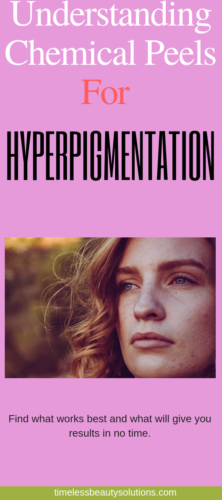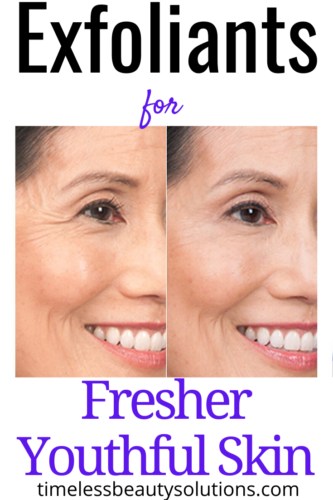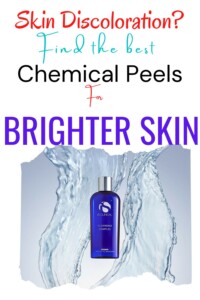Hyperpigmentation is referred to the discoloration spots on the skin. They are darker than the rest of the skin.
Skin spots could be red, pink, brown, or purple, but in general, they are referred to as dark spots. A higher level of melanin pigment than normal causes hyperpigmentation of the skin.
Melanin is the pigment that is solely responsible for the pigmentation of the skin. It gives it color. In excess, it causes hyperpigmentation.
It can occur in different skin levels such as epidermis, deeper dermis, or even on both layers.
In this post, I will share with you different peels for hyperpigmentation and help you understand how to know your peel tolerance.
Although hyperpigmentation is not harmful so to speak, in a world where beauty is at the forefront, skin freckles and discolorations are something to be corrected to most people. Common hyperpigmentation is the sunspots.
Types Of Hyperpigmentation
Sun Spots:
It is the result of sun damage. Too much exposure to UVA/UVB causes skin damage.
Post Inflammatory Hyperpigmentation (PIH)
Hyperpigmentation caused due to skin trauma, injury, or inflammation.
Melasma:
This hyperpigmentation is caused by the changes in hormonal levels usually during pregnancy, menopause, or while taking birth control.
Risk Factors Leading To Hyperpigmentation
- Spending too much time in the sun
- Acne-prone skin
- Skin conditions such as eczema or psoriasis
- Hormonal imbalances
- Sensitive skin
- Skin Trauma
- Old age
- Some medications
- Genetics
Understanding Chemical Peels
Chemical facial peels have proven one of the most effective in the treatment of various skin problems such as acne, scarring, anti-aging, pigmentation, and melasma.
If you have never used a chemical peel before and know next to nothing about it, it can be very daunting to figure out which peel would work for you.
To make it easier, keep in mind that a stronger peel is not always the better peel. Also, note that different people have different skin types.
Hence, different peels work for different people. The peel is usually stronger than the regular over-the-counter skincare product.
How Does Chemical Peel Work?
Chemical peels are what we call acid solutions. They have a pH level that is significantly lower than the natural pH level of the skin.
When you apply a chemical peel on the skin, It can dissolve the adhesive substance that is responsible for holding build-up layers of dead-skin buildup on the skin.
The dead skin, henceforth, will dry out and begin to disintegrate. It gets peeled off of your face giving way to fresh and new skin. This is a painless process.
Chemical Peels are no magic solution but they can help with:
-
- Anti-aging
- Acne
- Scars
- Wrinkles
- Fine-Lines
- Balance Skin Tone
- Decrease Discoloration
- Treat Hyperpigmentation
- Decrease prominence of Sunspots and other UV related issues
- Melasma
- Smooth textural issues
Know Your Chemical Peel Tolerance Level
Level 1
Is excellent for the first-timers. You may experience a slight tingly or itchy feeling. People with high tolerance won’t feel a thing.
Level 2
Perfect for those who need more benefits than just the mildest acids can offer. You may again experience a light tingle or an itch but it can very well sting a bit too.
Level 3
Is suitable for those who are receiving professional peels or for those who want to up the tolerance level. You may experience an intense stinging sensation and your skin may become hot.
You may like:
Skincare routine for ouly skin
Who Is a Chemical Peel Not Suited For?
It`s been proven that fair-skinned people get better results with chemical peels. If you have a darker skin tone, your chemical peel results may not be as impressive. People with darker skin tones also tend to get uneven skin after a peel.
Although chemical peels are meant to give you youthful skin, deep/severe wrinkles do not really benefit from these peels.
If you have deep wrinkles and want visible results, you`ll need a more extensive beauty procedure like tissue fillers(but that`s not for here or now).
You can find more info about soft tissue fillers for deep wrinkles here.
Best Facial Peels For Hyperpigmentation
This is a light-natured alpha hydroxy glycolic acid peel. It can either give a dramatic or very minimal result. It depends on the strength of the peel.
Glycolic acid has a small molecule. This molecule can penetrate the skin epidermis easily.
Due to being water-soluble, it is commonly used in treating common skin problems such as anti-aging issues, sun damage, wrinkles, and the appearance of skin.
Using Glycolic peels for at least 6-8 treatments weekly or bi-weekly will get the job done.
Beta hydroxy salicylic is an oil-soluble acid. It is extremely beneficial for skin problems such as clogged pores and acne.
It has anti-inflammatory as well as antimicrobial properties.
Salicylic acid can be tolerated by all skin tones and types. It has proven very effective for post-inflammatory pigmentation, oily skin, and rough skin.
It is used for treating acne and acne vulgaris. Using salicylic peels for at least 6-8 treatments weekly or bi-weekly will get you very good results.
Mandelic Peel
Alpha hydroxy mandelic acid peel is a milder acid peel. It gives excellent results when treating acne, skin pigmentation, wrinkles, and melasma.
It does not possess the risks of PIH( post-inflammatory hyperpigmentation). Check for side effects here.
Mandelic acid peel has a larger molecule.
This molecule can penetrate the epidermis at a slow and even pace. It has proven itself as an excellent acid choice for all skin types.
This is a safe peel. You can use it 6-8 times weekly or bi-weekly.
Alpha hydroxy lactic peel is another milder irritation acid that gives a subtle to no visible skin peeling. Hence, it is excellent for “light” peeling.
Lactic acid peel stops the tyrosinase enzyme activity directly. That is what makes it a good alternative to deal with skin pigmentation issues.
Lactic peel also helps in the improvement of dry skin. Again, 6-8 weekly or bi-weekly treatments will give you good results.
TCA (Trichloroacetic Acid) Peel
TCA is an acid with versatile uses. It can be used as a superficial peel, as well as for deeper penetration. All skin types and tones can generally tolerate TCA very well.
It is very effective in dealing with skin pigmentation, wrinkles, rough skin, photodamage, acne, and scarring.
6-8 weekly or bi-weekly treatments will produce wanted results.
Check other rough skin removing tips here
Traditionally, Jessner’s chemical peel has an equal concentration of resorcinol, lactic, and salicylic acids, i.e., of 14%. It is a preferred peel for oily and acne-prone skin. It is a safe peel.
Jessner’s peel can work with all skin tones and types. You can even alternate it with TCA peels.
The same 6-8 weekly or bi-weekly treatments will do the job. Swap to monthly after that to keep skin the way you love.
Can You Prevent Hyperpigmentation?
Now it`s almost impossible to avoid hyperpigmentation because this occurs as you age but with some loving care to your skin and finding the right facial peels for hyperpigmentation, you can reduce your chances of getting skin discoloration prematurely.
- Wear sunblocking clothes. (Here you can find tips on choosing sunblocking clothing)
- Cover your head with a hat whenever possible.
- When possible, avoid going to the sun at its strongest(between noon and 4 Pm although this will depend on where you live).
- Use Sunscreen faithfully, go for a minimum of SPF 40 if possible.
Conclusion On Facial Peels For Hyperpigmentation
Chemical peels have ingredients that help remove dead skin cells and work to reveal new fresh from underneath.
There are certain precautions one should take before using skin peels(especially if you are new to skin peeling, to minimize the risk of hyperpigmentation.
While using chemical peels, keep in mind that there should not be any discomfort after the procedure. After using the peel, moisturize the skin with a healing ointment.
Consult a dermatologist if you require deeper penetration in facial peels for hyperpigmentation to discuss other options.
If you prefer not to use chemical peels, look at using microdermabrasion for your skincare needs, I wrote a lengthy post here on how Microdermabrasion works.
You may like
Skincare routine for oily skin
Skincare products for combination skin
Want to check out any of the above mentioned facial peels for hyperpigmentation and skin discoloration then 
I hope this post will help you choose the right peel to suit your needs. If you have any questions, please leave me a message below.



When I was younger I never did anything special for my skin, as I have aged, I have found my face needs a little more up keep. I turn 42 this year and have started using a lot more facial products to help with the aging process and one of them is using a facial peel. The facial peel has worked wonders and my face feels so much better after each use.
Like you, I`m nolonger in my 20s so I take more care of my face than I did in the past, even though in the past I still took care of my skin very well.
As we age, the skin demands more TLC to be the way we want it to be, thankfully there are enough products out there to make skin care easier.
I used to not bother about pigmentation when I was younger, but now that I am older, I am starting to worry. Now, I am considering using these peels and actually evaluating which one should I use. Thanks for this helpful article, I am now aware that I belong to the beginners and there’s a specific peel to use for cases like mine. I’d like to ask, can you recommend a product that has no stingy sensation? I am quite nervous about that stingy sensation you’re saying.
just be gentle when using skin peels, advising on what will not sting will be hard as I do not know your skin type and how you wash and take care of your face.
I really enjoyed reading this. Though I am eczema-prone and do not use peels for my skin, I find it really interesting to read about the various strengths of peels and what they are used for.
Personally, my facial skin is dry and I sometimes suffer from rough skin. on my chin. However, I just juice plenty of veggies and blend with avocado. I also have started eating oily fish like mackerel, For the essential fatty acids it contains.
I really like your site and notice there are too few Beauty Sites to review at WA. Keep giving us tips on beauty!
Thanks for sharing.
This is a great article and it must definitely be applauded for enlightening us on the issue of recognising the facial peel tolerance level of every individual. I personally suffer from hyper pigmentation and this is such an helpful one for me. Though I always favor natural approach to treating my skin but I think I need the help of a chemical substance to aid my cure from this hyper pigmentation especially eczema. Thanks for this great help, I will surely get one out of the listed products
Glad you found the post useful, glad to know you`re using natural products, for me, I`ve never really tried any natural product as they take ages to show results.
Thank you so much for sharing this. As I grow older I develop this freckles out of nowhere and it is everywhere on my face! The last thing that I want is for them to turn into mold or something. I just want a nice youthful skin. I might need Mandelic Peel for my skin. Do I have to avoid sun if I use it? What other chemical that I have to watch out for? Thanks!
Start with lower acid concentrations when starting with Mandelic acid for facial peeling. It`s true as we age, our skin changes and the smooth youthful skin starts to sag. But with proper skincare you can delay signs of aging.
Awesome job. Funny enough, my sister and I were just talking about getting a chemical peel. I have sadly a couple of dark spots on my face from to much sun in my youth. She recommended a chemical peel to help them be not so dark and noticeable. This post just came at the right time, you have really helped me feel confident that this is what I need to purchase. I will be bookmarking your site and be going back to reread it. Thank you
thanks Coralie,glad you found the post helpful.
Thank you for this eye opening article for facial peels for fragmentation. My room mate who happens to be more of a brother to me was infected with chicken pox about 2 or 1 month ago. Even though It is nothing serious he has a few spots left on his face and is trying to get rid of them. I will try share this with him just on case he may think of buying some of the peels that you have listed in this article.
Thanks for stopping by Donny
Thank you for explaining the hyper pigmentation types and their causes. I have never thought to use a chemical peel and it is great that you have explained well for first time users. The Glycolic Peel sounds like something I would want to try as it is subtle to the skin. Thank you for this great and insightful article.
Glad you found the post useful.